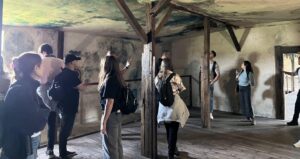A young boy taking care of some goats in the desert by the Dead Sea threw a stone into a cave, but the sound it made was not the sound he was expecting… He went inside to investigate. He found that the stone had hit a clay jar, and that inside the jar were some very old looking parchments with writing on them. What had he stumbled across?
This is how over a thousand ancient manuscripts were discovered in the northwestern side of the Dead Sea close to a site call “Qumran” between the years 1947-1956, in 11 different caves. The scrolls were written around 250 BCE – 70 CE, putting them in the Second Temple period and at time of the New Testament. Written mainly in Hebrew and Aramaic (as well as a few in Greek) they reveal the thought patterns of that movement in Judaism in that time. Though we use the word “scrolls” to describe them, most of the manuscripts are only fragments no bigger than one page, mostly written on parchment in ink.
The content of the scrolls are 40% copies of biblical texts, 10% copies of Deuterocanonical texts also found in other places, and 50% are unique texts of the Qumran community. There are no known copies of text from the New Testament. The question is then, why are the Dead Sea Scrolls so important to us for understanding the Old and the New Testaments?
The Biblical Manuscripts of the Dead Sea Scrolls
The Dead Sea Scrolls reveal manuscripts of many books of the Old Testament that are more ancient than any manuscript ever known before. Before the Dead Sea discovery, the most ancient whole text we had in Hebrew was the Masoretic text from the 10th century, and the oldest complete biblical text was the Septuagint (LXX), a Greek translation from the 4th century. The Dead Sea Scrolls, however, were written about a thousand years earlier, most of them even before the time of the New Testament.
The Dead Sea Scrolls contain parts from each book of the Old Testament, except the Book of Esther, and many complete copies of some of the books, such as Deuteronomy, Isaiah, Psalms, and others, but the contents of the manuscripts are much more important than their age or number.
Comparing the text of the Dead Sea Scrolls to the Old Testament we have today (meaning the Masoretic text) we find them almost identical. This shows the Bible has not been corrupted for two thousand years!
The Bible we have today is the same text as the text from the first century BCE, besides small changes in the lettering and very few textual changes, which are a common phenomenon in every ancient manuscript. This high level of preservation of the texts proves that the Old Testament we have today is a very accurate copy of the original text of Old Testament. There has been no “Chinese whispers”, no embellishment, and no corruption, and there is physical evidence to demonstrate this fact in the Israel Museum.
The Dead Sea Scrolls and Ancient Judaism
All of the scrolls were found less than two kilometers from the site of Qumran, by the Dead Sea. Digs at the site date it between the first century BCE and the first century CE. Therefore, the connection between the Qumran site and the scrolls is robust and significant, from the aspects of both time and geographical proximity. It is reasonable to assume that some, but not all of the scrolls were written by scribes from the settlement of Qumran.
Because of the close connection between the content of the scrolls and the settlement, most scholars hypothesize that an Essene community lived in Qumran. The Essenes were a movement within Judaism that emphasized a stringent way of live based on the Law of Moses and an expectation of the coming of Messiah in their day. The community called itself “Yahad” (together) and saw itself as representing the real Judaism, as opposed to the corrupt Judaism connected to the Second Temple in Jerusalem.
But even more interesting is the content of the scrolls dealing with subjects very similar to the subjects dealt with in the New Testament, such as the nature of righteousness and the coming of the Messiah according to the prophecies in the Old Testament.
The Essenes were not a Christian community, but they dealt with the same subjects the Christian community dealt with. The numerical distribution of biblical manuscripts found in the Dead Sea Scrolls closely parallels the numerical distribution of quotes from the Old Testament found in the New Testament. However, there is no such significant parallel between the numerical distribution of the scrolls and that of quotes from the Old Testament found in the Mishnah.
The content of the Dead Sea Scrolls shows clearly that what is called Second Temple Judaism had many different movements within it and wasn’t a monolithic movement, just as we see in today’s Judaism. Though the New Testament does not mention the Essenes specifically, it mentions different movements in Judaism, such as the Pharisees, the Sadducees, the Zealots and others.
Around 50% of the Dead Sea Scrolls are unique manuscripts, not found anywhere else. Those manuscripts show the lifestyle and manners of thinking of the Jewish community that lived in Qumran about two thousand years ago. They serve as an important source from which we can better understand the Judaism of that time and the Jewish background of the New Testament. Not a single manuscript found amongst them relates directly to early Christianity, but we can learn a lot about the social, cultural, political and religious environment of the time of Yeshua and his disciples.
R. Brown
You can find out more about the Dead Sea Scrolls and how they shed new light on the New Testament in our online course: “THE DEAD SEA SCROLLS & THE NEW TESTAMENT”
















